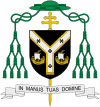Our Lady of Ipswich was a Marian shrine in Ipswich before the English Reformation. Among Marian shrines, only the shrine at Walsingham attracted more visitors.

The Sanctuary of Our Lady of Lourdes is a Catholic Marian shrine and pilgrimage site dedicated to Our Lady of Lourdes in the town of Lourdes, Hautes-Pyrénées, France. The sanctuary includes several religious buildings and monuments around the grotto of Massabielle, the place where the events of the Lourdes apparitions occurred in 1858, among them are three basilicas, the Basilica of Our Lady of the Immaculate Conception, the Rosary Basilica and the Basilica of St. Pius X, respectively known as the upper, lower and underground basilica.
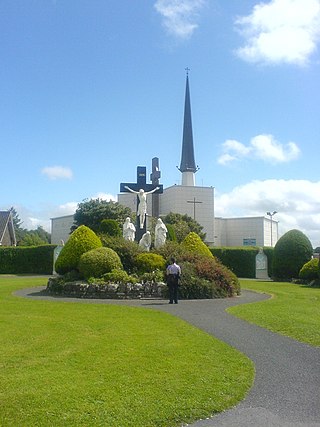
The Sanctuary of Our Lady of Knock, commonly referred to as Knock Shrine, is a Roman Catholic pilgrimage site and national shrine in the village of Knock, County Mayo, Ireland, where locals claimed to have seen an apparition in 1879 of the Blessed Virgin Mary, Saint Joseph, Saint John the Evangelist, angels, and Jesus Christ.

Our Lady of Walsingham is a title of Mary, mother of Jesus venerated by Catholics and High Church Anglicans associated with the Marian apparitions to Richeldis de Faverches, a pious English noblewoman, in 1061 in the village of Walsingham in Norfolk, England. Lady Richeldis had a structure built named "The Holy House" in Walsingham which later became a shrine and place of pilgrimage.
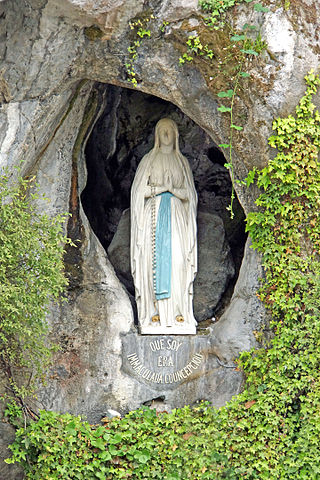
Our Lady of Lourdes is a title of the Virgin Mary. She is venerated under this title by the Roman Catholic Church due to her apparitions that occurred in Lourdes, France. The first apparition of 11 February 1858, of which Bernadette Soubirous told her mother that a "Lady" spoke to her in the cave of Massabielle while she was gathering firewood with her sister and a friend. Similar apparitions of the "Lady" were reported on 18 occasions that year, until the climax revelation in which she introduced herself as: "the Immaculate Conception". On 18 January 1862, the local Bishop of Tarbes Bertrand-Sévère Laurence endorsed the veneration of the Blessed Virgin Mary in Lourdes.

The Basilica of Holy Mary, the Help of Christians also known as the National Shrine of Our Mother of Sheshan is a Roman Catholic Marian shrine in Shanghai, China. Its name comes from the locality of Sheshan Hill in Songjiang District, to the west of Shanghai's metropolitan area.

The Diocese of Menevia was a Latin Church diocese of the Catholic Church in Wales. It was one of two suffragan dioceses in the ecclesiastical province of Cardiff and was subject to the Archdiocese of Cardiff, until it merged with the archdiocese in 2024, to form the Roman Catholic Archdiocese of Cardiff-Menevia.

The Diocese of Wrexham is a Latin Church ecclesiastical territory or diocese of the Catholic Church in Wales. The diocese is a suffragan in the ecclesiastical province of the metropolitan Archdiocese of Cardiff-Menevia.
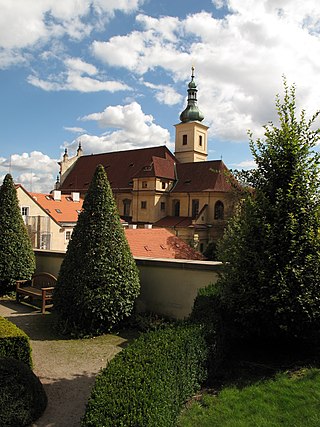
The Church of Our Lady of Victories, also referred as the Shrine of the Infant Jesus of Prague, in Malá Strana, the "Lesser Quarter" of Prague, is a church governed and administered by the Discalced Carmelites.

The Shrine of Our Lady of Madhu is a Roman Catholic Marian shrine in Mannar district of Sri Lanka. With a history of more than 400 years, the shrine acts as a center of pilgrimage and worship for Sri Lankan Catholics. The site is considered as the holiest Catholic shrine in the island and is a well known place of devotion for both Tamil and Sinhalese Catholics. The church has been a symbol of unity not just between Tamils and Sinhalese but also between people of different religions, including Buddhists, Hindus and Protestants.

Christianity has a strong tradition of pilgrimages, both to sites relevant to the New Testament narrative and to sites associated with later saints or miracles.

Our Lady of Manaoag is a Roman Catholic title of the Blessed Virgin Mary venerated in Manaoag, Pangasinan, the Philippines. The sacred statue is referred to as Apo Baket in the native language of local devotees.

The Basilica of Our Lady of Walsingham, informally known as the Slipper Chapel or the Chapel of Saint Catherine of Alexandria, is a Catholic basilica in Houghton Saint Giles, Norfolk, England. Built in 1340, it was the last chapel on the pilgrim route to Walsingham.

Our Lady of Peace and Good Voyage, also known as Our Lady of Antipolo and the Virgin of Antipolo, is a seventeenth-century Roman Catholic wooden image of the Blessed Virgin Mary as venerated in the Philippines. This Black Madonna is enshrined in Antipolo Cathedral in the Sierra Madre mountains east of Metro Manila.

Our Mother of Sheshan or Our Lady of Sheshan (佘山聖母), also known as Our Mother of Zo-sè, is a celebrated Marian title of the Blessed Virgin Mary venerated by Chinese Roman Catholics. Among its religious devotees, the statue is sometimes known as Our Lady of Luck or Our Lady of Good Luck due to the Chinese symbology of "Fu" (福) associated with the styling posture of the entire image. The original image is currently enshrined in the National Shrine and Minor Basilica of Our Lady of Sheshan, in Shanghai, China.

Our Lady of the Good Event of Parañaque (Spanish: Nuestra Señora del Buen Suceso de Parañaque; Filipino: Ina ng Mabuting Pangyayari ng Parañaque is the name of a statue of the Madonna and Child enshrined in St. Andrew's Cathedral in Parañaque, Philippines. The original Spanish name is often incorrectly rendered in English as Our Lady of Good Success due to the superficial similarity between the Spanish word "suceso" and the English false friend "success."
Sister Concordia Scott was a Scottish sculptor and Benedictine nun, of the Minster Abbey community, Minster-in-Thanet, Kent. Her commissioned works have included statues for Westminster Abbey, Canterbury Cathedral, Coventry Cathedral and the National Shrine of Wales as well as numerous sculptures currently in Europe and the United States of America.

Our Lady of Willesden is a title of the Blessed Virgin Mary venerated by Christians in London, especially by Anglicans, Catholics, and Eastern Orthodox. It is associated with the historic image (statue) and pilgrimage centre in the community of Willesden, originally a village in Middlesex, England, but now a suburb of London. The pre-Reformation shrine was home to the Black Madonna of Willesden statue.
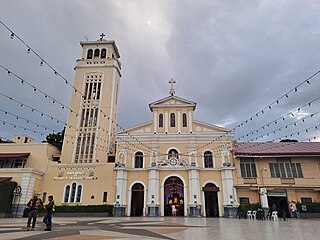
The Minor Basilica of Our Lady of the Rosary of Manaoag, commonly known as Manaoag Church, is a Roman Catholic minor basilica located in Manaoag, Pangasinan in the Philippines. It is under the jurisdiction of the Archdiocese of Lingayen-Dagupan. The shrine is dedicated to the Blessed Virgin Mary under the title of Our Lady of the Rosary. The original shrine was founded in 1600, it is administered by the Order of Preachers and is a popular tourist and pilgrimage site among devotees.

Nuestra Señora de la Purificación y la Candelaria is a venerated image of the Blessed Virgin Mary enshrined in Jaro Cathedral and the patroness of Western Visayas.



















